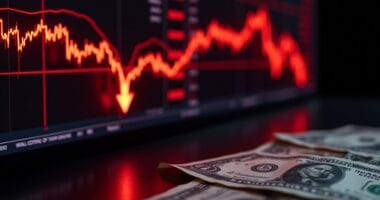JPMorgan CEO Jamie Dimon is sounding alarm bells about the US bond market as national debt rockets past $36 trillion. The numbers are staggering: $4.27 billion added daily, with each American now owing $106,447. Rising Treasury yields signal investors demanding higher returns, while mounting interest payments eat up 13.55% of federal spending. With debt projected to hit $37 trillion by Halloween 2025, Dimon’s warning about market stability might be more than just Wall Street drama.

While politicians debate spending and fiscal responsibility, America’s mountain of debt has exploded to a mind-numbing $36.21 trillion. The numbers are staggering: $4.27 billion added daily, or $49,431 per second. That’s right – in the time it took to read this sentence, Uncle Sam borrowed enough to buy a luxury car.
Jamie Dimon, JPMorgan’s straight-talking CEO, isn’t mincing words about the dangers lurking in the bond market. And who can blame him? With publicly held debt at $28.95 trillion and another $7.26 trillion in intragovernmental obligations, the Treasury Department’s printing press is working overtime. They’re churning out bills, notes, bonds, and fancy inflation-protected securities like there’s no tomorrow. The Debt to the Penny dataset tracks these eye-popping figures at the end of each business day.
The math is brutal. Every American now owes $106,447 – including babies born yesterday. Per household? A whopping $273,904. At this rate, we’ll hit $37 trillion by Halloween 2025. Spooky doesn’t begin to describe it.
America’s debt burden is staggering: over $106,000 per person, nearly $274,000 per household. The scariest part? It keeps growing.
May 2025’s federal deficit clocked in at $316 billion – a slight improvement from last year, but still historically massive. Meanwhile, interest payments are eating up an ever-larger slice of the federal pie, projected to reach 13.55% of outlays this fiscal year. That’s money that won’t fix roads, fund research, or help veterans. These fiscal challenges highlight why central banks play such a crucial role in managing national economies through monetary policy.
For those seeking more detailed information about these fiscal concerns, the Senate Index provides comprehensive resources on financial legislation and policy. The bond market is showing signs of indigestion from all this debt-feeding. Treasury yields are climbing as investors demand higher returns for their risk. It’s a vicious cycle: more borrowing leads to higher rates, which leads to more borrowing to pay the interest.
And if foreign buyers get queasy about holding all those Treasury securities? Well, that’s when things could get really interesting.
The consequences are already visible. Private investment is getting crowded out. Economic growth is under pressure. And the government’s ability to respond to future crises? Let’s just say it’s not improving.
If this debt train doesn’t slow down, we might all need to buckle up for a bumpy ride.





